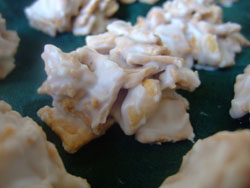Candy Canes
The following text is drawn from our featured Christmas book and is also available for free as audio. Also, as a teaching tool, you can download our handout on the symbolism of candy canes.
 The traditional Christmas candy cane is white with red stripes and flavored with peppermint. Though several accounts make their claim to be the “true story” of the origin of the candy cane, history reveals that, most likely, it took several centuries and the contributions of several countries for the candy cane to evolve into its current form.
The traditional Christmas candy cane is white with red stripes and flavored with peppermint. Though several accounts make their claim to be the “true story” of the origin of the candy cane, history reveals that, most likely, it took several centuries and the contributions of several countries for the candy cane to evolve into its current form.
It appears that the candy cane has its origin in the plain white candy sticks invented in the early 1400s. The most credible story for how the sticks became canes is based on an incident that took place more than 200 years later in Germany. In 1670, the Cologne Cathedral hosted a living Nativity Scene for its Christmas celebration. The choirmaster had great difficulty keeping the children of the choir in order, so he got creative. Plain white candy sticks were popular with the children, and the choirmaster believed that if they were kept busy licking candy, they wouldn’t chatter so much. But the choirmaster wanted more than just keeping the children quiet; he wanted them to learn something of the significance of the Nativity. He appealed to a local candy maker to bend the sticks in the form of shepherd’s staffs.
Legend holds that the choirmaster used his ingenious design to encourage the children to watch how the shepherds of the Nativity used their canes to direct the live animals. More importantly, the choirmaster could instruct the children to consider how Jesus became the “Good Shepherd.”
The shape and purpose of a shepherd’s cane is significant. The design is meant to literally hook sheep by the neck in order to lead them to better nourishment (pastures, water, etc.) or to rescue them from harm. For nervous and fearful sheep, the sight of the shepherd’s staff is a great comfort. Surely that is why the psalmist David could say to the Lord his shepherd, “I will fear no evil, for you are with me; your rod and your staff, they comfort me” (Psalm 23:4b).
The choirmaster’s idea became so popular that the practice of passing out candy canes at living Nativity scenes spread throughout Europe. They could be used not only as a teaching tool, but to serve another practical purpose — their shape made them an ideal decoration to easily hang on a Christmas tree.
In regard to the red striping on candy canes, it is possible that the Swedish town of Granna (known as the peppermint candy capital of the world) influenced the addition. Peppermint candies with red stripes first appeared in the town in the mid-19th century. At this time, candy canes were still portrayed in plain white on Christmas cards throughout Europe and America. However, by the early 20th century, candy canes were depicted with their familiar red stripes.
Though some popular stories credit American confectioners with inventing the candy cane, historical evidence conflicts with these claims. It is possible, however, that an American was the first to infuse the candy cane with extensive Christian meaning.Though the candy cane was notdesigned with intentional symbolism (beyond its shape), it has proven to be a useful teaching tool. It seems appropriate to use it as such, particularly if its original form was meant to teach children about Christ, the Good Shepherd. The most common symbolism is as follows:
The hard candy reminds us that Jesus is our rock. — Psalm 61:2
The cane shape reminds us of a shepherd’s staff and the shepherds that came to worship Jesus. It also reminds us of how Jesus came into the world to be a shepherd of his people. — Luke 2:8-15 and John 10:11
The upside-down candy cane forms the letter “J” and reminds us of the name of Jesus which means “God saves.” — Matthew 1:21
The peppermint flavor reminds us of the gift of spices from the Wise Men. — Matthew 2:11
The white candy reminds us of purity and holiness. It recalls the virgin birth of Christ, the sinless life of Christ and the holy life that Jesus wants his people to live. — Matthew 1:23 and 1 Peter 1:15
The color red reminds us that Jesus became a real flesh and blood man and spilled his blood to save his people. — Hebrews 2:14
The stripes remind us of the lashes Jesus received when he suffered for us and ultimately bore our sins that we might be healed. — 1 Peter 2:24-25
Back to Main Christmas Symbols Page.
We welcome your questions and feedback. If you are seeking information on candy canes that is not found on our website, please contact us.
This content has a copyright © 2008 by Angie Mosteller. Please cite the source if you use this material: http://www.celebratingholidays.com/?page_id=1528.






